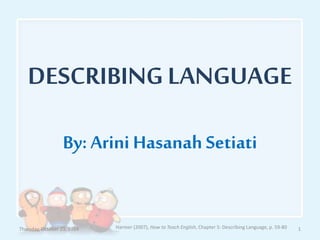
Describing Language
- 1. DESCRIBING LANGUAGE By: Arini Hasanah Setiati Thursday, October 23, 2014 Harmer (2007), How to Teach English, Chapter 5: Describing Language, p. 59-80 1
- 2. OUTLINE: Meaning in Context and Language Function The Element of Language Forms and Meanings Hypothetical Meaning Words Together Text and Discourse Language Variables Conclusion Thursday, October 23, 2014 Harmer (2007), How to Teach English, Chapter 5: Describing Language, p. 59-80 2
- 3. MEANING IN CONTEXT AND LANGUAGE FUNCTION The sentence used in speaking or writing may perform different language function. Language function is a purpose you wish to achieve when you say or write something. Functioning properly in conversation or writing depends on reacting to the context in which we are using the language and on the relationship between words and ideas. Thursday, October 23, 2014 Harmer (2007), How to Teach English, Chapter 5: Describing Language, p. 59-80 3
- 4. THE ELEMENT OF LANGUAGE The elements of language have to be put together to get the meaning across. Thursday, October 23, 2014 Harmer (2007), How to Teach English, Chapter 5: Describing Language, p. 59-80 4 Grammar/ Parts of Speech • A successful sentence depends on putting a number of elements in the correct order. • Parts of speech helps to determine how grammatical sequences are put together and which words can go in which slots. Vocabulary • Some words in a sentence is to express a particular meaning. Pronunciation • The way the sentence spoken determines exactly what it means.
- 5. FORMS AND MEANINGS The same language forms can be used to express different meanings. A meaning can be expressed by many different forms. E.g. * One form, many meanings. ‘Book’ (= something to read; to reserve; a list of bets, etc.) ‘Beat’ (= to win; to hit; to mix, etc.) * One meaning, many forms. - I’ll see you tomorrow. - I’m going to see you tomorrow. - I’m seeing you tomorrow. Thursday, October 23, 2014 Harmer (2007), How to Teach English, Chapter 5: Describing Language, p. 59-80 5
- 6. HYPOTHETICAL MEANING “Something that is not real, but it might be the case.” Thursday, October 23, 2014 Harmer (2007), How to Teach English, Chapter 5: Describing Language, p. 59-80 6 Modal Verbs • It might rain ≠ It will rain. • I would go if I could ≠ I can’t go. Conditional Sentences • If you brought your umbrella, you would not get wet (hypothetical).
- 7. WORDS TOGETHER There are three specific instances of words that group together: Thursday, October 23, 2014 Harmer (2007), How to Teach English, Chapter 5: Describing Language, p. 59-80 7 E.g. fast asleep; get away; heavy traffic, etc. Collocat ions E.g. glad to see you; nice to see you; great to see you, etc. Lexical Chunks E.g. down to earth; full of beans; a piece of cake, etc. Idiom
- 8. TEXT AND DISCOURSE Text must have cohesion (the way we connect ideas and sentences together) and coherence (internal logic). When the text is coherent, the readers should be able to perceive the writer’s purpose and follow their line of thought. To make a successful conversation, participants need to be proficient at turn taking, they should avoid long silences, and they should listen when someone else is speaking. Thursday, October 23, 2014 Harmer (2007), How to Teach English, Chapter 5: Describing Language, p. 59-80 8
- 9. LANGUAGE VARIABLES A. Speaking and Writing In speaking, speakers can use paralinguistic (non-language) features to modify the meaning of context. E.g. changing tone of voice; gesturing; using face expression, etc. In writing, writers can use tricks to create rhythm and effect. E.g. dashes (-); exclamation mark (!); new paragraphs, etc. Thursday, October 23, 2014 Harmer (2007), How to Teach English, Chapter 5: Describing Language, p. 59-80 9
- 10. Cont. B. Register It refers to the topic the speakers speaking about and the tone that wished to be adopted. It is needed to be able to recognize register differences to choose the words appropriately. Thursday, October 23, 2014 Harmer (2007), How to Teach English, Chapter 5: Describing Language, p. 59-80 10
- 11. Cont. C. Language Varieties There are many different English varieties being used around the world. The international English belongs to everyone who speaks it, but it is no one’s mother tongue. English learners should be aware of those English varieties, and should be given opportunities to experience different ‘Englishes’ to make things comprehensible to them Thursday, October 23, 2014 Harmer (2007), How to Teach English, Chapter 5: Describing Language, p. 59-80 11
- 12. CONCLUSION • There are several elements and variables of English language description such as the nature of meaning in context, language functions, the nature of words and their morphology, the elements of pronunciation, and so on, which should be well understood by language teachers and learners in order to be able to comprehend the language precisely, and use it properly both in speaking and writing as productive skills. Thursday, October 23, 2014 Harmer (2007), How to Teach English, Chapter 5: Describing Language, p. 59-80 12
- 13. Thursday, October 23, 2014 Harmer (2007), How to Teach English, Chapter 5: Describing Language, p. 59-80 13
